Beans, beans, they’re good for your heart. I won’t finish that familiar rhyme but the first part is thankfully very much true. Each of the three components in this concise side dish are beans or bean products. This doesn’t include the drops of vinegar, which was made with rice. However, if you served this with steamed rice to make for a complete meal, you’d essentially be eating a typical Eastern version of “beans and rice.” (See what I meant about how universal this formula is?)
And good for your heart. My heart, or my energy level so far as I could actually tell, really needed this healthy, simple meal this week. I’ve been eating so much greasy, meaty foods lately — on a brief vacation with my family last week, and at food events before and after it. My friends and family tend to convene in order to share elaborate meals together, and it was a nonstop eating spree for a while there. It was time to slow down from it all.
If you’re ever feeling like this, I can’t tell you how good it feels to bite into a block of pure, clean and white tofu. Even if you think you can’t stand the bean protein. The soothing, creamy texture and mild, nutty flavor will refresh your palate and senses like a cup of tea. Unlike fresh cheeses (such as minimally processed mozzarella or ricotta), there’s no fat that’s going into your system along with it, and I tend to appreciate both these foods served cold in a very similar way.
I prefer silken tofu varieties when enjoying them cold, for their appropriately silken, custard-like texture. Soft tofu (simply meaning less dense and with more water content) is fine to use here instead, but it’s processed slightly differently, with less finely crushed soybeans. Do yourself a $4 favor and buy one block of each types of tofu — one that’s described as “silken” and one that’s not. You’ll notice immediately the difference in textures between them, whether or not you get the firm or soft subcategories of silken tofu (and vice-versa). But the neutral taste will be the same.
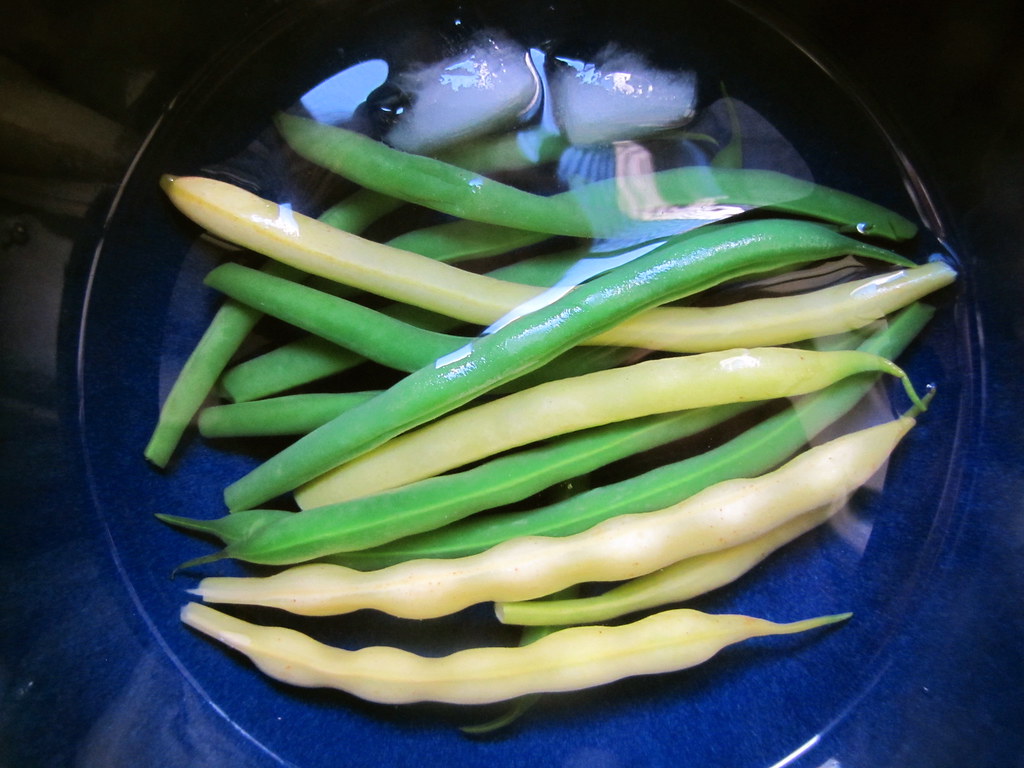 yellow wax beans and green beans are blanched and shocked in ice water
yellow wax beans and green beans are blanched and shocked in ice water
Then there’s string beans — or “pole beans” — a broad family of legumes that are my favorite types for eating raw or very lightly cooked. They include skinny, green haricot verts, lemon-yellow wax beans, purple and green string beans, and heirloom varieties like the plump romano beans. Sweet and crisp, they grow all summer long, often quite prolifically as you may have observed if you’ve ever tended a plant twisting around their namesake, needed poles. To bring out their colors and make them more tender, I quickly blanched these beans in boiling water for a minute, before transferring to an ice bath to stop the cooking process dead in its tracks.
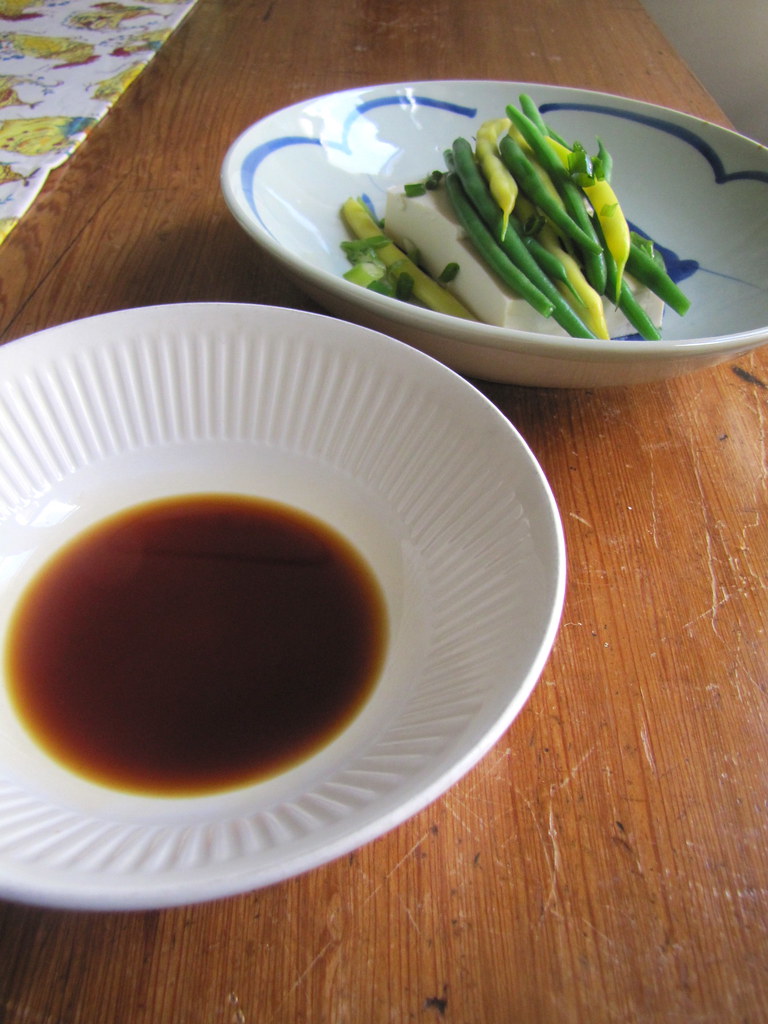
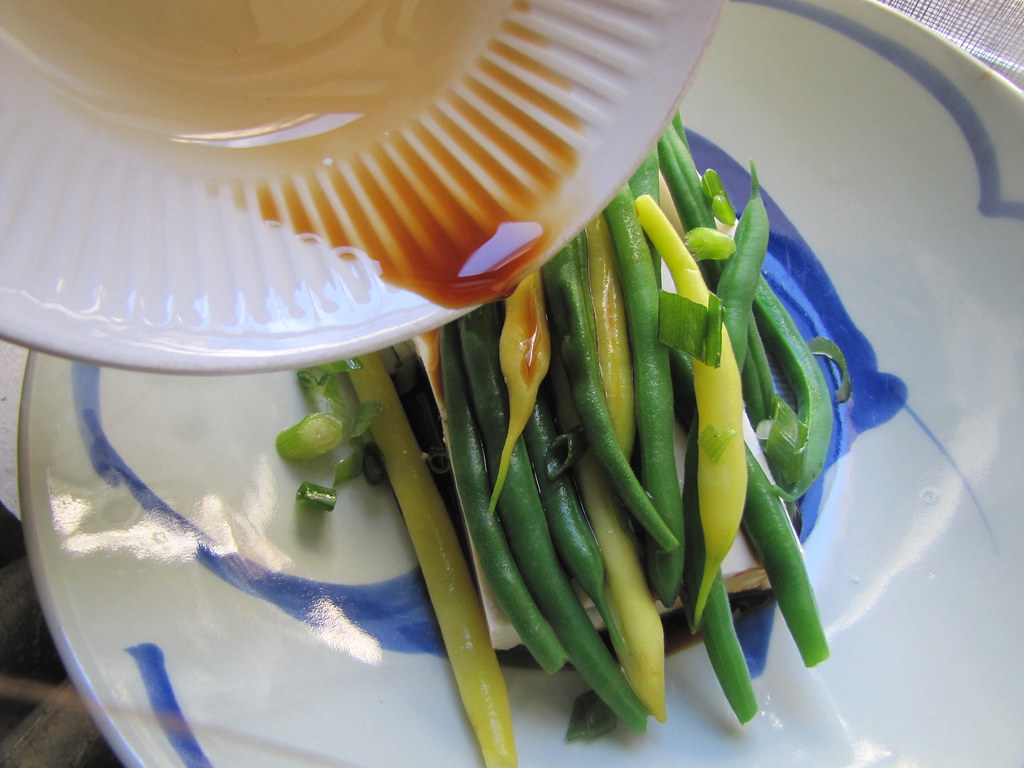 soy sauce with a splash of rice vinegar creates a thin, piquant sauce
soy sauce with a splash of rice vinegar creates a thin, piquant sauce
To marry these two very different relatives (tofu, made with the curds of cooked soybeans and fresh string beans), we turn to yet another bean: fermented soybean sauce. Doused over the whole dish, this salty, umami-rich substance adds yang to the yins — although it has no fat or animal products either. I splurged on an authentic Japanese shoyu, a somewhat sweeter-tasting soy sauce than most Chinese styles. Growing up with only Chinese soy sauces in my pantry, this is just a little more exotic and exciting for me to use.
Any soy sauce can be substituted, however (such as Kikkoman, a common Japanese brand). And a splash of rice vinegar mixed in stretches the saltiness to create a thin, oil-less vinaigrette that soaks into the tofu and beans. I like to crumble up the tofu bit by bit, alternating between bites of the snappy string beans. The tofu will cling to the beans a little, and the sauce will sit at the bottom of the plate in case you want to mop your pieces with it more. A sprinkle of fresh chopped scallions is an optional touch, and you could add toasted sesame seeds, cilantro, or any fresh herb for garnish. I kept the toppings pretty minimal this time. So fresh and so clean-tasting, it was a cool contrast on its own.
String Beans with Silken Tofu and Vinegared Soy Sauce
(makes about 2 servings)
1/2 lb assorted string beans (such as green beans and yellow wax beans)
8 oz. block firm silken tofu
3 tablespoons Japanese soy sauce (or “shoyu”)
1 tablespoon rice vinegar
1 fresh scallion, chopped (optional)
Bring a pot of water to a boil. Prepare a bowl of ice water. Trim stems from the beans and submerge in the boiling water for 30 seconds to 1 minute. Transfer with tongs immediately to the ice bath and let sit until cool. Drain.
Combine the soy sauce and vinegar in a small bowl. Chop the tofu into cubes and place at the bottom of serving plates. Arrange the blanched beans on top of the tofu. Pour the sauce over. Top with the optional chopped scallions and serve immediately.
Cost Calculator
(for 2 servings)
8 oz. block silken tofu: $1.99
1/2 lb green beans (from Berried Treasures farm stand at Union Square Greenmarket): $2.00
3 tablespoons fancy Japanese soy sauce: $1.00
1 tablespoon rice vinegar: $0.20
1 scallion: $0.35
Total: $5.54
Health Factor![]()
![]()
Two brownie points: With heart-healthy tofu and string beans, this dish is a powerhouse of plant-based protein. Barely cooking the fresh string beans helps retain its plentiful nutrients, which include Vitamin C, Vitamin K and fiber. The only place that can get a little slippery on the health scale is how much sodium you end up splashing over the whole thing. Try to use as little soy sauce as you can get by on, the stuff will soak in over time and you can always add more. It would be disastrous to accidentally pour more soy sauce than you actually want in the first place over the whole dish, rendering it too salty to your taste (and high in sodium). But soy sauce and vinegar have valuable health benefits of their own as fermented foods, including promoting a healthy heart.
Green Factor![]()
![]()
![]()
![]()
![]()
![]()
![]()
Seven maple leaves: Organically grown soybeans and the tofu made from it are widely available and very inexpensive (especially compared with organic meats and dairy). This is begging you to buy it, and more often, as the protein takes a smaller toll on the environment to produce. It’s a good time to scoop up string beans at the farmers markets also, as these protein-packed plants are still growing strong in this region. As for my Japanese soy sauce and rice vinegar, these are imported products but one bottle of each should last a pretty long time.
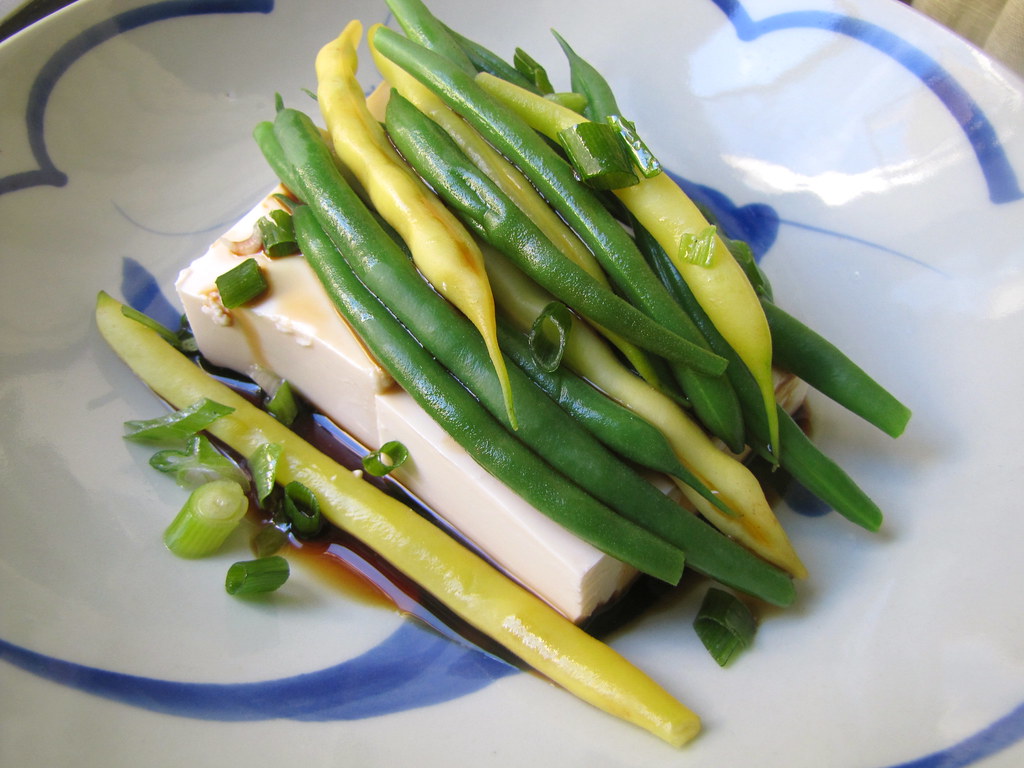
 a block of firm silken tofu
a block of firm silken tofu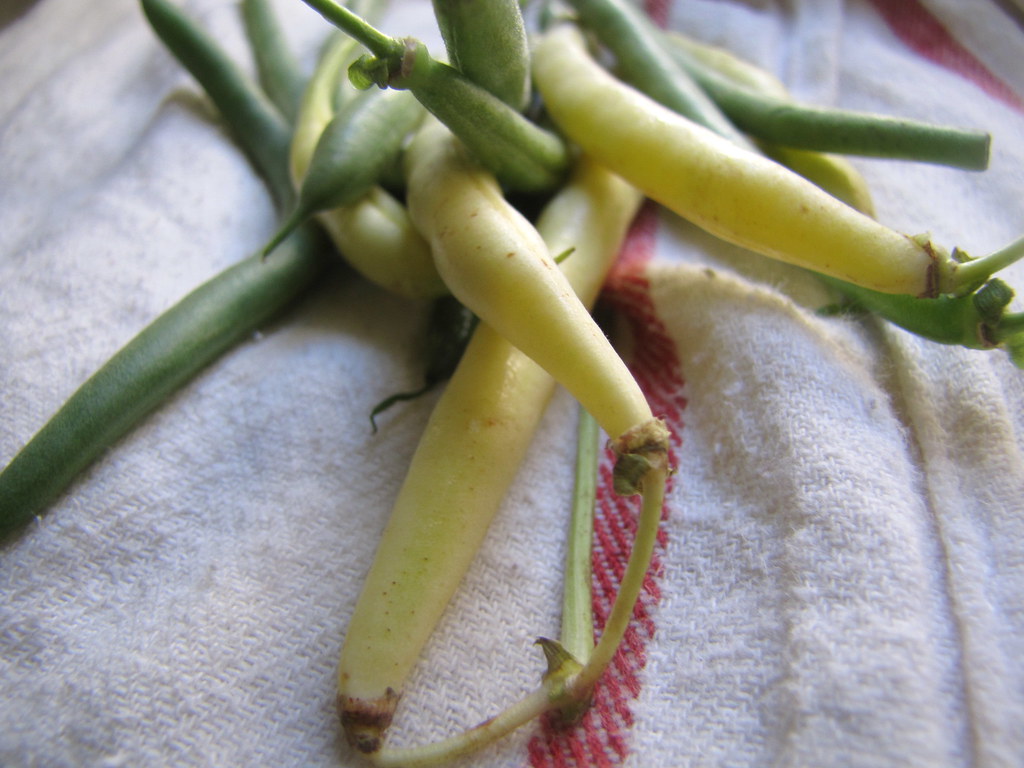
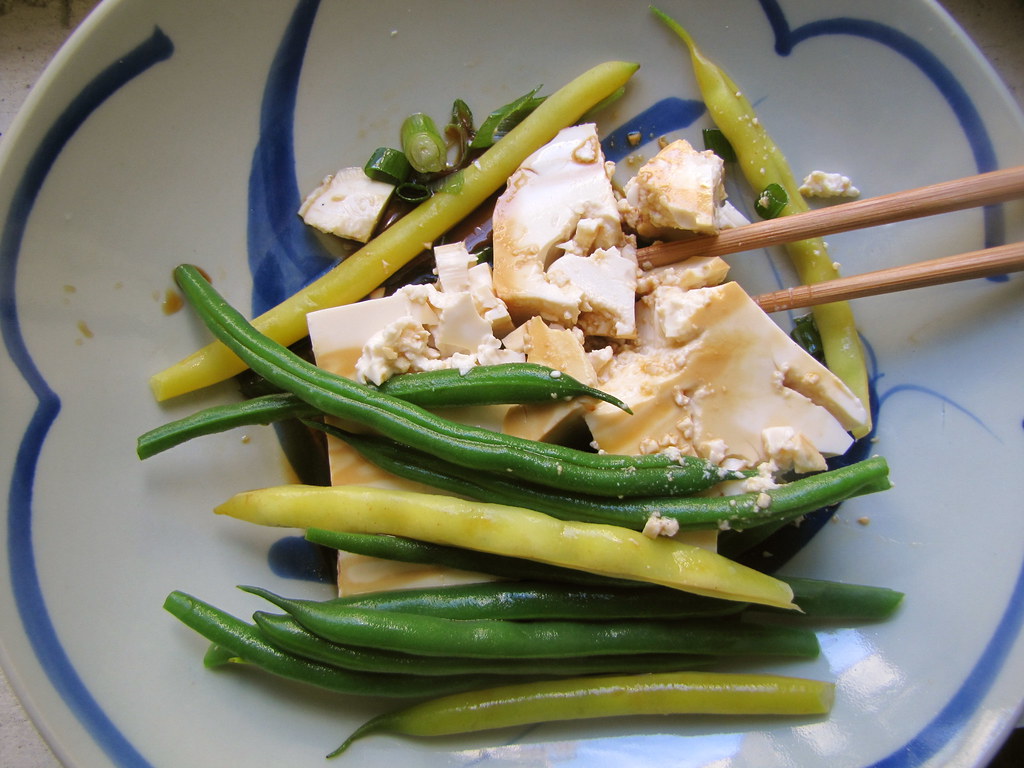
One Response
jasonsmith smith
Thank you so much for this. I was into this issue and tired to tinker around to check if its possible but couldnt get it done. Now that i have seen the way you https://tracktrace.onl/usps/ did it, thanks guys
with
regards